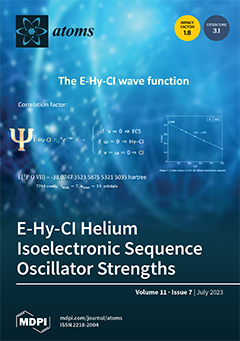The exponentially correlated Hylleraas–configuration interaction method (E-Hy-CI) is a generalization of the Hylleraas–configuration interaction method (Hy-CI) in which the single
of an Hy-CI wave function is generalized to a form of the generic type
[...] Read more.
The exponentially correlated Hylleraas–configuration interaction method (E-Hy-CI) is a generalization of the Hylleraas–configuration interaction method (Hy-CI) in which the single
of an Hy-CI wave function is generalized to a form of the generic type
. This work continues the exploration, begun in the first two papers in this series (on the helium atom and on ground and excited
states of Li II), of whether wave functions containing both linear and exponential
factors converge more rapidly than either one alone. In the present study, we examined not only 1
states but 1
s2
p states for the He I, Li II, Be III, C V and O VII members of the He isoelectronic sequence as well. All
energies except He I are better than previous results. The wave functions obtained were used to calculate oscillator strengths, including upper and lower bounds, for the He-sequence lowest (resonance)
transition. Interpolation techniques were used to make a graphical study of the oscillator strength behavior along the isoelectronic sequence. Comparisons were made with previous experimental and theoretical results. The results of this study are oscillator strengths for the 1
1
s2
He isoelectronic sequence with rigorous non-relativistic quantum mechanical upper and lower bounds of (0.001–0.003)% and probable precision ≤ 0.0000003, and were obtained by extending the previously developed E-Hy-CI formalism to include the calculation of transition moments (oscillator strengths).
Full article





